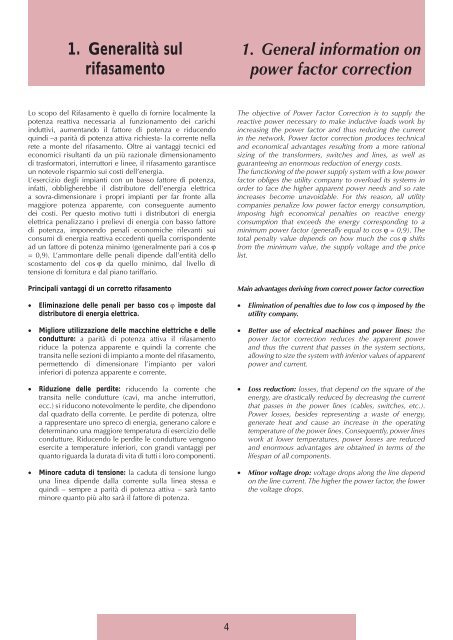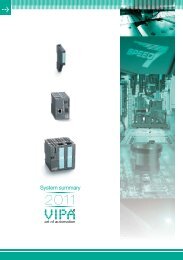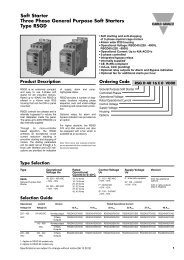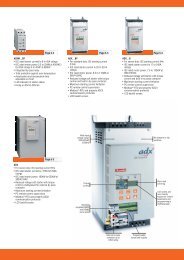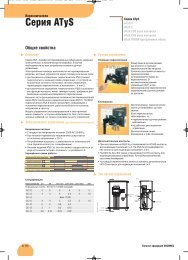condensatori sistemi e filtri mt e at rifasamento industriale capacitors ...
condensatori sistemi e filtri mt e at rifasamento industriale capacitors ...
condensatori sistemi e filtri mt e at rifasamento industriale capacitors ...
Create successful ePaper yourself
Turn your PDF publications into a flip-book with our unique Google optimized e-Paper software.
1. Generalità sul<br />
<strong>rifasamento</strong><br />
1. General inform<strong>at</strong>ion on<br />
power factor correction<br />
Lo scopo del Rifasamento è quello di fornire localmente la<br />
potenza re<strong>at</strong>tiva necessaria al funzionamento dei carichi<br />
induttivi, aumentando il f<strong>at</strong>tore di potenza e riducendo<br />
quindi –a parità di potenza <strong>at</strong>tiva richiesta- la corrente nella<br />
rete a monte del <strong>rifasamento</strong>. Oltre ai vantaggi tecnici ed<br />
economici risultanti da un più razionale dimensionamento<br />
di trasform<strong>at</strong>ori, interruttori e linee, il <strong>rifasamento</strong> garantisce<br />
un notevole risparmio sui costi dell’energia.<br />
L’esercizio degli impianti con un basso f<strong>at</strong>tore di potenza,<br />
inf<strong>at</strong>ti, obbligherebbe il distributore dell’energia elettrica<br />
a sovra-dimensionare i propri impianti per far fronte alla<br />
maggiore potenza apparente, con conseguente aumento<br />
dei costi. Per questo motivo tutti i distributori di energia<br />
elettrica penalizzano i prelievi di energia con basso f<strong>at</strong>tore<br />
di potenza, imponendo penali economiche rilevanti sui<br />
consumi di energia re<strong>at</strong>tiva eccedenti quella corrispondente<br />
ad un f<strong>at</strong>tore di potenza minimo (generalmente pari a cos ϕ<br />
= 0,9). L’ammontare delle penali dipende dall’entità dello<br />
scostamento del cos ϕ da quello minimo, dal livello di<br />
tensione di fornitura e dal piano tariffario.<br />
Principali vantaggi di un corretto <strong>rifasamento</strong><br />
• Eliminazione delle penali per basso cos ϕ imposte dal<br />
distributore di energia elettrica.<br />
• Migliore utilizzazione delle macchine elettriche e delle<br />
condutture: a parità di potenza <strong>at</strong>tiva il <strong>rifasamento</strong><br />
riduce la potenza apparente e quindi la corrente che<br />
transita nelle sezioni di impianto a monte del <strong>rifasamento</strong>,<br />
permettendo di dimensionare l’impianto per valori<br />
inferiori di potenza apparente e corrente.<br />
• Riduzione delle perdite: riducendo la corrente che<br />
transita nelle condutture (cavi, ma anche interruttori,<br />
ecc.) si riducono notevolmente le perdite, che dipendono<br />
dal quadr<strong>at</strong>o della corrente. Le perdite di potenza, oltre<br />
a rappresentare uno spreco di energia, generano calore e<br />
determinano una maggiore temper<strong>at</strong>ura di esercizio delle<br />
condutture. Riducendo le perdite le condutture vengono<br />
esercite a temper<strong>at</strong>ure inferiori, con grandi vantaggi per<br />
quanto riguarda la dur<strong>at</strong>a di vita di tutti i loro componenti.<br />
• Minore caduta di tensione: la caduta di tensione lungo<br />
una linea dipende dalla corrente sulla linea stessa e<br />
quindi – sempre a parità di potenza <strong>at</strong>tiva – sarà tanto<br />
minore quanto più alto sarà il f<strong>at</strong>tore di potenza.<br />
The objective of Power Factor Correction is to supply the<br />
reactive power necessary to make inductive loads work by<br />
increasing the power factor and thus reducing the current<br />
in the network. Power factor correction produces technical<br />
and economical advantages resulting from a more r<strong>at</strong>ional<br />
sizing of the transformers, switches and lines, as well as<br />
guaranteeing an enormous reduction of energy costs.<br />
The functioning of the power supply system with a low power<br />
factor obliges the utility company to overload its systems in<br />
order to face the higher apparent power needs and so r<strong>at</strong>e<br />
increases become unavoidable. For this reason, all utility<br />
companies penalize low power factor energy consumption,<br />
imposing high economical penalties on reactive energy<br />
consumption th<strong>at</strong> exceeds the energy corresponding to a<br />
minimum power factor (generally equal to cos ϕ = 0,9). The<br />
total penalty value depends on how much the cos ϕ shifts<br />
from the minimum value, the supply voltage and the price<br />
list.<br />
Main advantages deriving from correct power factor correction<br />
• Elimin<strong>at</strong>ion of penalties due to low cos ϕ imposed by the<br />
utility company.<br />
• Better use of electrical machines and power lines: the<br />
power factor correction reduces the apparent power<br />
and thus the current th<strong>at</strong> passes in the system sections,<br />
allowing to size the system with inferior values of apparent<br />
power and current.<br />
• Loss reduction: losses, th<strong>at</strong> depend on the square of the<br />
energy, are drastically reduced by decreasing the current<br />
th<strong>at</strong> passes in the power lines (cables, switches, etc.).<br />
Power losses, besides representing a waste of energy,<br />
gener<strong>at</strong>e he<strong>at</strong> and cause an increase in the oper<strong>at</strong>ing<br />
temper<strong>at</strong>ure of the power lines. Consequently, power lines<br />
work <strong>at</strong> lower temper<strong>at</strong>ures, power losses are reduced<br />
and enormous advantages are obtained in terms of the<br />
lifespan of all components.<br />
• Minor voltage drop: voltage drops along the line depend<br />
on the line current. The higher the power factor, the lower<br />
the voltage drops.<br />
4


